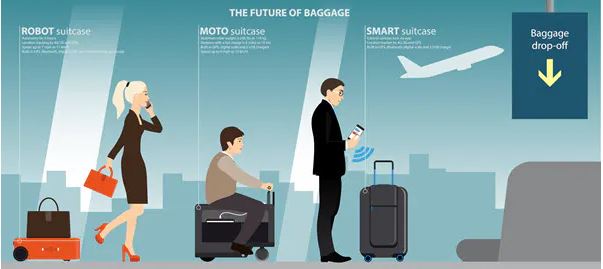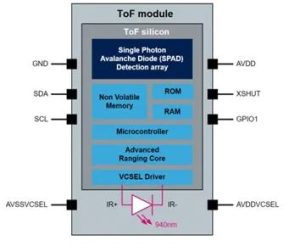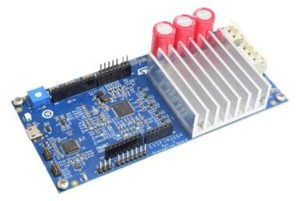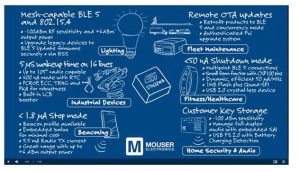How Engineers Tackle Consumer Autonomous Robot System Challenges
When people hear “autonomous mobile robots (AMRs)”, many imagine relatively large robotic systems operating in order fulfillment centers, warehouses, or various industrial applications. Few would imagine artificial intelligence/machine learning (AI/ML) powered rolling suitcases dutifully following their owners as they travel to destinations across the globe. Even fewer would imagine this technology is available commercially today. The dawn of household AI/ML systems and robotics is here. To further enable this revolution, engineers must overcome several hardware and software hurdles to meet TSA approval and fit all necessary electronic systems within a compact space that doesn’t substantially increase weight while keeping costs competitive.
Here, we discuss the trends in small consumer AMR systems—specifically luggage and the various hardware and software concerns—and design challenges associated with bringing small consumer AMR systems to the masses.
AMR Luggage for the 21st Century Traveler
Hauling luggage through airports, train stations, and bus stations is generally one of most people’s greatest drags associated with long-distance travel. Hence, it is surprising that there has been little innovation in luggage design over the past few decades. While luggage has undergone an aesthetic overhaul in the past 20 years, not much has been done regarding real technological advancement. Fortunately, this has all changed recently. AMR luggage systems designed to track and follow their owner using only onboard systems are now commercially available.
This is a significant evolution from typical smart luggage, which includes luggage systems that have built-in batteries for charging smartphones, GPS, open detection, and some you can even ride on. With the latest AMR luggage systems, AI/ML technology is used to navigate the dizzying and cluttered environment from home, through a transit station, and on to the user’s destination. This type of navigation requires sophisticated vision systems, proximity detection systems, smartphone interfacing, and mobile robotic electronics.
Challenges with Small Consumer AMR System Design
Unlike industrial AMR systems, consumer AMR luggage is relatively small and must remain low-weight and easy to use, even when not operating. Moreover, industrial robots are designed to be safe in intrinsically dangerous industrial environments, where consumer AMR must work in less-controlled environments. Therefore, along with the general need for mobile robots to be efficient, reliable, and responsive, small/personal AMR luggage systems must also account for the chaos of busy transit terminals and distracted users. This requires relatively sophisticated AI/ML that can track, follow, and navigate a chaotic environment where unintended collisions may be unavoidable.
Small Consumer AMR AI/ML Vision Systems & Proximity Sensors
While a 2D camera image can provide context, a proximity system is still needed to determine distance and depth from physical objects. Therefore, sensor fusion is critical for small AMR luggage, which is expected to zip alongside a user without excessive guidance.
Sensor fusion is a common method for a robotic system to gain greater insight into the environment than a regular 2D camera image would reveal. Robotic vision systems used to be rather bulky and expensive but have progressively shrunk as vision systems, and proximity sensor packages have become more compact and more readily used for machine vision.
For AMR luggage to maintain the svelte aesthetic appeal of modern luggage, the proximity sensors and vision system must be compact enough to fit within a smooth profile without being too overt. This puts additional space constraints on the vision and proximity systems and necessitates greater levels of integration, possibly with a collective vision and proximity system on a single compact PCB. This approach toward hyper-compactness may also be necessary to reduce the weight associated with AMR electronics for manual use.
Hence, a time-of-flight sensor that uses invisible 940nm infrared (IR) light in a small package could be ideal for such an application. IR sensors can be protected by optically clear lenses at IR frequencies but are relatively opaque at visual light frequencies. Moreover, target color and reflectance invariants include sensors that employ Vertical Cavity Surface Emitting Laser (VCSEL) IR technology for time-of-flight sensing (Figure 1).
Figure 1: Functional diagram of a VCSEL time-of-flight IR proximity sensor 511-VL53L5CXV0GC/1 ideal for use in AMR luggage applications.
Small Consumer AMR Mobility
Mobility systems are a significant design focus for small AMRs. The responsiveness, efficiency, and reliability of a small AMR system are largely dictated by the quality of the design and choice of devices/components that go into the AMR mobility system. A typical AMR mobility system includes electric motors, motor drivers, and motor control system, as well as the energy storage, usually an electric battery. Highly efficient motor control microcontroller units (MCUs) are likely the best option for such a compact and low-power application. Other motor control solutions may be less power efficient and have a larger footprint even if higher performance is possible, such as field-programmable gate array (FPGA) solutions.
A small consumer AMR luggage will likely use small, brushless DC (BLDC) motors, usually three phases, to achieve the responsiveness and efficiency desirable for this application. However, BLDC motors require a specialized motor controller and driver technology that can drive three separate phases simultaneously with sensor input capability and enough power to handle the computation load of BLDC motor control mathematics.
In the past, motor control systems like this required a complete custom design of each feature and the necessary resources to iteratively design a functional solution. Now, BLDC motor controllers with embedded MCUs provide a highly integrated solution that can easily be more compact and possibly even more efficient than prior less-integrated approaches (Figure 2). These highly integrated solutions aid development time, reduce PCB area and minimize overall Bill of Materials (BOM) complexity.
Figure 2: A highly integrated motor controller/MCU, such as the STMicroelectronics STSPIN32G4, can provide advanced motor control features and processing in a single package. The image above is the STMicroelectronics EVSPIN32G4 Demonstration Board with the STSPIN32G4 system-in-package (SiP) and STL110N10F7 power MOSFETs.
Small Consumer AMR Wireless Communication
Small consumer AMR luggage also needs to be readily provisioned and controlled by the user through ordinary means. Moreover, modern electronics can benefit from over-the-air (OTA) upgrades, especially with new and experimental products like AMR luggage. This means that AMR luggage systems also need to incorporate a variety of wireless standards to be compatible with a user’s smartphone and possibly connect to other IEEE 802.15.4 wireless protocols for testing, diagnostics, or other smart home feature integration.
Given AMR luggage’s space and power constraints, separate wireless chips can significantly increase board area, especially when considering the need to maintain electromagnetic compatibility (EMC) compliance with a design. Hence, a microcontroller with built-in wireless capability, such as Bluetooth® Low Energy 5 (BLE5) and IEEE 802.15.4™ communication protocols, could significantly ease the development process and enable more rapid development of a wireless capable AMR luggage (Figure 3).
Figure 3: A multi-protocol wireless microcontroller system-on-chip (SoC) can greatly benefit the design and development of IoT devices while extending application battery life.
Conclusion
Though flying cars are still developing, robotic luggage that autonomously follows its user and eliminates some of the drudgeries of long-distance travel is here today. The future will see more innovative robotic luggage ideas emerge, which all must contend with fitting autonomous mobile robotics systems in a highly compact package while ensuring safety and user-friendliness.
Source: Mouser Electronics











